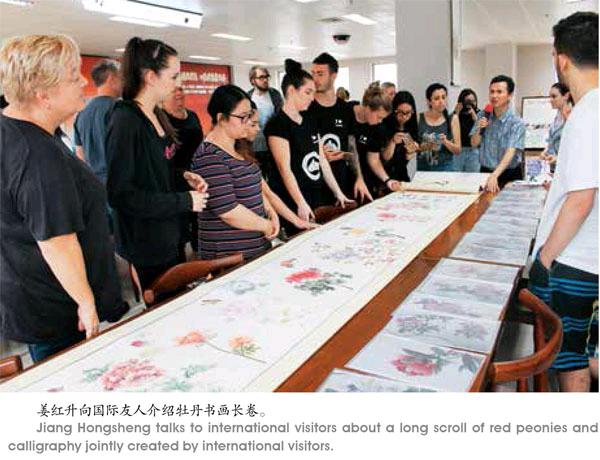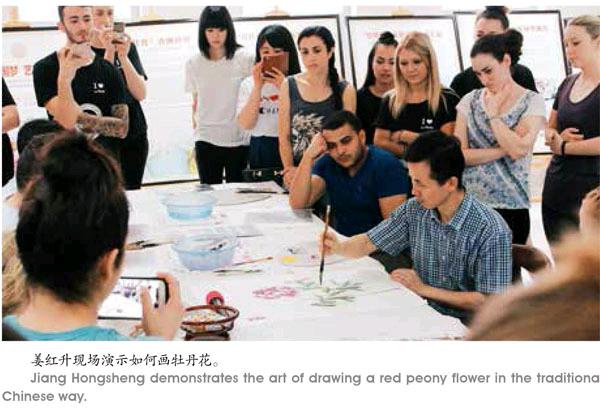外籍学生恋上中华书画
2017-09-07沈翊
沈翊
2017年6月26日,第六届宁波国际大学生节在甬拉开帷幕。本届大学生节在宁波市人民政府外事办的引领下,邀请了来自20多个国家的200多名师生参与。各国大学生怀着对中国传统书画艺术的热爱,来到宁波大学图书馆红牡丹书画国际交流社,在“红牡丹”创始人姜红升老师的带领下,第一次接触毛笔的外籍人士在短短的2小时内,画出一幅幅令人惊叹的牡丹花画作。中国文化国际传播“红牡丹”模式,探索出一条“2小时内让外籍人士爱上中国”的神奇魅力。

姜紅升向师生们介绍了在中华人民共和国成立66周年时,来自英国、德国、法国、意大利、俄罗斯、美国、加拿大、巴西、玻利维亚、印度、韩国、巴基斯坦、尼日利亚、马达加斯加、澳大利亚等五大洲66个国家的国际友人,齐聚宁波“红牡丹”,在9.9米长的同一幅画卷上,用古远华夏的笔墨,创作66朵不同颜色牡丹的书画长卷,表达对新中国的祝福。
姜红升现场演示了如何绘画牡丹花。全英语的交流,耐心的指导,令学员们乐在其中。大家纷纷拿起画笔开始学习描画牡丹花。
浙江大学宁波理工学院乌克兰籍教师康斯坦丁在“红牡丹”已经学习了三年时间,是一名资深的国画助教,从最初的中国文化的学习者,成长为一名中华文化的传播者,从红牡丹公益书画教学的受益者成为跨国公益的践行者与“领头羊”。
以牡丹为绘画题材的中国书画艺术,历来被书画家钟情与喜爱。雍容华贵、婀娜多姿的牡丹,素有“国色天香”、“花中之王”的美称,中国人民把牡丹看作是人类和平、幸福美好、繁荣富贵的象征。牡丹花是中国的国花,牡丹是中国的,更是世界的。象征着人类和平、幸福美好、繁荣富贵的牡丹更是体现当代中国文化的内涵与中国人民的精神追求。不同语言、不同肤色、不同民族的国际大学生,调和着不同色彩的国画颜料,描绘着“精彩美丽”这同一个梦想。
外籍师生兴奋地互相展示他们创作的牡丹花。一些优秀学员被邀请在已有160多个国籍人士描绘的牡丹书画长卷上,延伸绽放这国色天香、富贵吉祥的“文化长城”。
以“花为媒”的艺术载体,从教授画一朵牡丹开始,带领国际友人走进诗意盎然的中国文化。牡丹的自然之美、文化之美、艺术之美,浓缩在国际友人创作的千姿百态书画牡丹中。国际友人在国色天香中国文化艺术的体验中,融入中国文化的国际“百花园”。
6月27日,来自英国、美国、法国、波兰、韩国、新加坡、马来西亚、印度尼西亚等8个国家的师生拿起毛笔,在姜红升老师的带领下,第一次接触中国书法艺术,临摹碑帖,认识中国汉字的魅力,领悟中国书法的博大精深。
从握笔、运笔到勾勒线条,姜红升细细解说,耐心传授,为第一次接触书法的学生们创造良好的学习气氛。
学生们认真观察着汉字的模样,姜红升在汉字的表情达意、书写笔顺、用笔技巧等方面悉心指导。
学习书法对于诺丁汉大学的学生们来说,是以一种充满仪式感的方式来接触与认识中国文化。他们不仅对汉字本身的结构充满新奇感,更为汉字所组成的成语、古籍经典、唐诗宋词等蕴含的深刻意义与营造的文化氛围所陶醉。
“上善若水,水善利万物而不争,处众人之所恶,故几于道。”“上善若水”源自《道德经》,学员们在了解了这个词是指像水的品性一样,泽被万物而不争名利的含义后,情不自禁地下笔挥毫。
学员们很喜欢“自强不息”一词,并将之作为自己的座右铭。

课堂中,不少同学是“左撇子”,但丝毫没有影响他们对书法的临习与创作,正所谓“左右开弓”,气势不凡。学员们对于中国的传统文化形式“春联”很感兴趣,在姜红升老师的带领下,先后在春联纸上写下自己的祝愿,既是对自己的鼓励,也表达了对中国传统优秀文化的赞美。
在询问了“I Love You”的中文表达后,一位祖籍巴基斯坦的英国留学生兴致满满地在纸上书写下了“我爱你”三个字,这是学员们对“红牡丹”的赞美,也是对中华传统文化的笔墨倾诉。
书法课堂欢声不断,在完成了书法练习后,学员们情不自禁地在春联上写下了“宁波红牡丹学院”,表达了对体验中国传统文化发自内心的喜爱。洋学生爱上了红牡丹。
新加坡学员欣喜地展示她书写的人生警言“厚德载物”。
两位马来西亚学员同样兴奋地展示她们书写的“万事如意”、“上善若水”、“厚德载物”、“自强不息”等,并特意要求为她们的书法作品用立轴装裱,作为本次文化艺术交流的珍贵记忆。
在两个小时内,外国学员对于中国书法艺术的体验与领悟,对于汉字书写的把控与挥洒,萍水相逢,惊鸿一瞥,暗香盈袖,最美不过初相见,恰如牡丹那般艳。浓情在华夏古老笔端的艺术之花,成了跨国交流中外友谊的幸福之花。
“红牡丹”以教育的方式传播文化,以文化的方式构筑友谊,以艺术的方式深化情感,学员们对中华文化的好奇、体验、挑战以及由挑战成功而产生的喜悦、充实、兴奋,老师对学生佳作的赞誉和欣赏,学生对中华文化的认同与喜爱,结出中外文化交流的丰硕成果。
The curtain came up on the 6th Ningbo International Students Festival on June 26, 2017, in Ningbo, a port city in eastern Zhejiang. Sponsored by the foreign affair office of the city government, over 200 international students and teachers in Ningbo participated. One of the events they enjoyed at the festival was a visit to Red Peony, an art learning project for international students, visitors and local expat community. Red Peony sits at the Library of Ningbo University.
Red Peony is the name of an art learning institution designed to teach foreigners in Ningbo to get started in traditional Chinese art and build up communications between China and the rest of the world.
Red Peony is also the name of an easy and hands-on approach for foreigners to learn how to paint a peony in the traditional style of Chinese painting within two hours. Traditional Chinese painting boasts a long history, a galaxy of ancient masters, and a great number of artworks. It would be a daunting challenge for a foreign non-artist to grab the essentials of the complex art within a short period of time. A red peony flower is the solution Jiang Hongsheng has developed. By learning how to paint a red peony, a non-artist foreigner could try her hands at holding a brush pen, learning basic ink strokes of a brush pen, and using simple colors. What is more, peony symbolizes fortune, peace, happiness, and prosperity in Chinese culture. It is Chinas unofficial national flower. Usually, a beginner could learn with ease how to paint a red peony within two hours.
Jiang Hongsheng, the founder of the society, gave the visitors a short talk about the easiness of picking up the essentials of Chinese painting. In 2015, the year that marked the 66th anniversary of the founding of the Peoples Republic of China, Red Peony invited 66 international students and teachers in Ningbo to create a 9.9-meter long drawing. They were from various countries and they drew 66 peonies in different colors. Jiang showed the visitors this long painting scroll.
After the talk, Jiang demonstrated how to paint a peony. His tips were easy to understand since Jiang speaks English fluently. Eventually they successfully drew peonies in different colors. Some of the visitors, due to their brilliant performance, were invited to add their peonies to an existing long scroll of peony painting created jointly by over 160 foreigners over a long period of time and on different occasions.
On June 27, Jiang Hongsheng met with international students and teachers from UK, USA, France, Poland, South Korea, Singapore, Malaysia, and Indonesia at Red Peony at the library. They are now learning or teaching at University of Nottingham Ningbo.
It was the first time that these foreigners tried their hands at Chinese calligraphy. For these students and teachers, the visit was like a ceremony. It opened a window for them to peep into the cultural magnificence of Chinese characters. For these beginners, Jiang had picked some phrases and concise sentences from ancient classics, which are still in widespread use in China today. Jiang explained these phrases and short sentences that act as mottos to the beginners, knowing it was very probably the first exposure these foreigners had to Chinese classics.
Jiang noticed something quite interesting at the class. Some foreigners were left-handed. He thought it quite unusual, for nearly all left-handed Chinese students write with their right hands, though their left hands use chopsticks or play the basketball nimbly. Jiang himself broadened his teaching experience by observing how these left hands held a brush pen and adjusting his instructions about how to move the pen to write ink strokes.
Like a class for learning how to paint a red peony, the calligraphy class lasted about two hours. After all, it wasnt very difficult for a foreigner to learn to write four or five Chinese words in a calligraphic style. Toward the end of the class, they asked Jiang how to write Red Peony and Ningbo in Chinese. They wrote them down accordingly. Some even decided to get their calligraphic works done on this occasion mounted or framed for memory.
